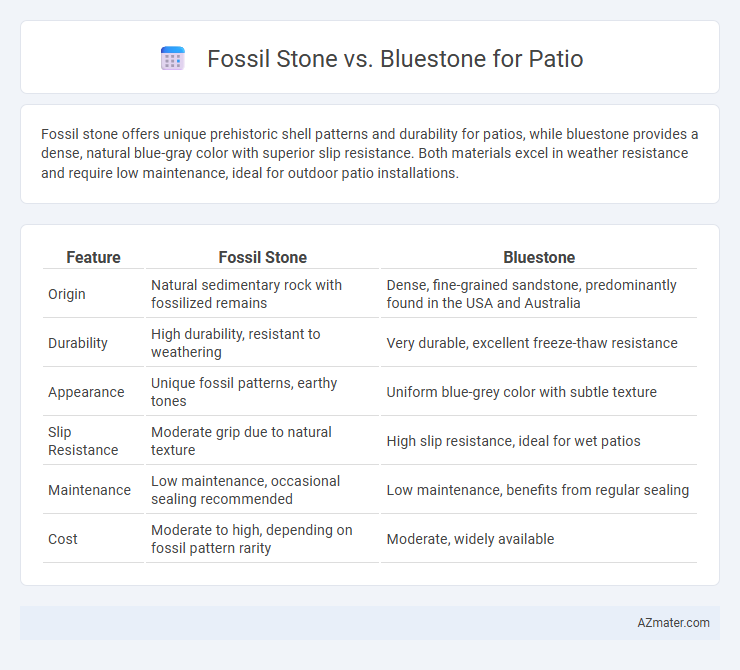Fossil stone offers unique prehistoric shell patterns and durability for patios, while bluestone provides a dense, natural blue-gray color with superior slip resistance. Both materials excel in weather resistance and require low maintenance, ideal for outdoor patio installations.
Table of Comparison
| Feature | Fossil Stone | Bluestone |
|---|---|---|
| Origin | Natural sedimentary rock with fossilized remains | Dense, fine-grained sandstone, predominantly found in the USA and Australia |
| Durability | High durability, resistant to weathering | Very durable, excellent freeze-thaw resistance |
| Appearance | Unique fossil patterns, earthy tones | Uniform blue-grey color with subtle texture |
| Slip Resistance | Moderate grip due to natural texture | High slip resistance, ideal for wet patios |
| Maintenance | Low maintenance, occasional sealing recommended | Low maintenance, benefits from regular sealing |
| Cost | Moderate to high, depending on fossil pattern rarity | Moderate, widely available |
Introduction to Patio Stone Choices
Fossil stone offers unique fossilized patterns and a natural, earthy aesthetic ideal for creating a distinctive patio surface, while bluestone provides a durable, dense composition with a smooth texture and consistent blue-gray hue. Both materials are excellent for outdoor use, but fossil stone tends to present more visual character with irregular shapes, whereas bluestone is prized for its uniform slabs and slip resistance. Selecting between fossil stone and bluestone depends on desired style, maintenance preferences, and budget considerations for long-lasting patio installations.
What is Fossil Stone?
Fossil stone is a natural sedimentary rock embedded with prehistoric marine fossils, providing a unique textured surface ideal for patios. Its intricate patterns and earthy tones create an aesthetically appealing and durable outdoor flooring option. Compared to Bluestone, fossil stone offers a distinctive fossil-rich appearance, making each patio slab a one-of-a-kind piece.
Understanding Bluestone
Bluestone, a dense and durable sandstone, offers exceptional weather resistance and slip-resistant properties making it ideal for patio surfaces exposed to various climates. Its natural blue-gray hues and smooth texture provide a sleek, modern aesthetic compared to the more rustic and textured fossil stone. Bluestone's low porosity reduces staining and requires minimal maintenance, outperforming fossil stone in long-term durability and ease of care for outdoor patios.
Aesthetic Differences: Fossil Stone vs Bluestone
Fossil stone features unique, intricate patterns with embedded prehistoric marine fossils, offering a natural, textured aesthetic that adds character and historical depth to patios. Bluestone is prized for its uniform, smooth surface and cool, rich blue-gray hues, providing a sleek, contemporary look with subtle variations that enhance modern outdoor spaces. Choosing between fossil stone and bluestone depends on whether the desired patio style emphasizes organic, antique charm or refined, minimalist elegance.
Durability and Longevity Comparison
Fossil stone exhibits exceptional durability due to its dense composition, making it resistant to weathering and heavy foot traffic, which extends its longevity in patio applications beyond 50 years with minimal maintenance. Bluestone, while durable, is more susceptible to chipping and erosion in harsh climates, often requiring sealing and more frequent upkeep to preserve its structural integrity over time. Choosing fossil stone for patios ensures a longer-lasting surface with superior resistance to environmental stressors compared to bluestone.
Slip Resistance and Safety Factors
Fossil stone offers a naturally textured surface that enhances slip resistance, making it a safer option for patios, especially in wet conditions. Bluestone, while durable and aesthetically pleasing with a smooth finish, can become slippery when wet unless treated with anti-slip coatings or finishes. Choosing fossil stone for patio construction provides superior safety due to its inherent rough texture, reducing the risk of slips and falls.
Climate Suitability: Which Performs Better?
Fossil stone offers excellent durability in hot, dry climates due to its dense composition and resistance to UV fading, making it ideal for patios exposed to intense sunlight. Bluestone performs better in cooler, wetter environments, as its natural slip resistance and moisture absorption properties prevent surface damage and enhance safety during rain or frost. Choosing between fossil stone and bluestone depends on the local climate, with fossil stone excelling in arid conditions and bluestone providing superior performance in humid or cold regions.
Maintenance Requirements
Fossil stone patios require minimal maintenance, benefiting from natural durability and resistance to staining, though occasional sealing helps preserve its fossil details. Bluestone demands more frequent cleaning and resealing to prevent discoloration and surface wear due to its porous nature. Both materials need regular sweeping, but fossil stone generally offers a lower long-term upkeep commitment compared to bluestone.
Cost Analysis: Fossil Stone vs Bluestone
Fossil stone typically costs between $8 and $15 per square foot, making it a budget-friendly option for patios compared to bluestone, which ranges from $15 to $30 per square foot due to its durability and aesthetic appeal. Installation expenses for both materials vary but fossil stone generally requires less intensive labor, slightly lowering overall project costs. When considering long-term value, bluestone's resistance to weathering and minimal maintenance can offset its higher initial price, offering better durability in outdoor patio settings.
Best Applications and Final Recommendations
Fossil stone, known for its unique organic patterns and durability, is ideal for decorative patios that emphasize natural aesthetics and slip resistance. Bluestone offers superior strength and a consistent blue-gray color, making it perfect for high-traffic areas requiring long-lasting structural integrity. For patios combining visual appeal with longevity, fossil stone suits artistic designs, while bluestone excels in functional, heavy-use outdoor spaces.

Infographic: Fossil stone vs Bluestone for Patio
 azmater.com
azmater.com